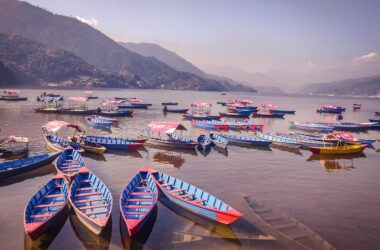Kailash Mansarovar, a place of immense spiritual and cultural significance, holds a special place in the hearts of Hindus, Buddhists, Jains, and people from various other faiths. Located in the remote western part of Tibet, this sacred mountain and its accompanying Mansarovar Lake have captured the imaginations of pilgrims and adventurers for centuries. Let’s explore the cultural significance of Kailash Mansarovar and the deep-rooted traditions associated with it.
Introduction
Kailash Mansarovar is revered by Hindus, Buddhists, and Jains as the abode of gods, a source of spiritual awakening, and a place of divine energy. The pilgrimage to Kailash Mansarovar is a profound journey that represents the soul’s quest for enlightenment and self-discovery.
1. The Sacred Mount Kailash and Mansarovar Lake
1.1 Significance in Hinduism
In Hindu mythology, Mount Kailash is believed to be the home of Lord Shiva, the destroyer and transformer of the universe. It is considered the ultimate pilgrimage site for devout Hindus who seek blessings, forgiveness, and liberation from the cycle of birth and death.
1.2 Significance in Buddhism
For Buddhists, Kailash is associated with the Buddha’s enlightenment and represents the “Diamond Throne.” It is believed that circumambulating the mountain can purify negative karma and lead to spiritual enlightenment.
1.3 Significance in Jainism
In Jainism, Kailash is regarded as a sacred place where several Jain Tirthankaras achieved spiritual enlightenment. The mountain holds deep symbolism of detachment from worldly desires and the pursuit of spiritual liberation.
2. Pilgrimage to Kailash Mansarovar
2.1 Spiritual and Cultural Importance
The pilgrimage to Kailash Mansarovar is not merely a physical journey but also a profound spiritual experience. It offers pilgrims an opportunity to connect with their inner selves, seek blessings, and attain spiritual growth. The cultural significance lies in the shared rituals and beliefs that unite people from different faiths during this transformative journey.
2.2 The Journey to Kailash Mansarovar
The journey to Kailash Mansarovar is arduous and demands physical endurance and mental strength. Pilgrims undertake a circumambulation of the mountain known as the parikrama, which is a clockwise ritual walk around the sacred peak. This demanding trek tests the pilgrims’ devotion and determination, fostering a sense of unity and camaraderie among fellow travelers.
3. Rituals and Beliefs Associated with Kailash Mansarovar
3.1 Circumambulation (Parikrama)
The circumambulation of Mount Kailash is a ritual followed by pilgrims from different faiths. It involves walking around the mountain, typically covering a distance of approximately 52 kilometers. This act of devotion is believed to cleanse sins, fulfill desires, and bring spiritual enlightenment.
3.2 Dip in the Mansarovar Lake
Mansarovar Lake, situated near Mount Kailash, is considered a sacred body of water with purifying qualities. Pilgrims take a dip in its holy waters, seeking spiritual cleansing and redemption. It is believed that a single dip can wash away a lifetime of sins and lead to salvation.
3.3 Symbolic Meaning of the Journey
The pilgrimage to Kailash Mansarovar holds symbolic significance. The challenging terrain, high altitude, and physical obstacles encountered during the journey represent the hardships and struggles faced in life. Overcoming these challenges is seen as a metaphorical path toward spiritual growth and enlightenment.
4. Mystical and Natural Wonders
4.1 The Unique Geography of Kailash Mansarovar
The region surrounding Kailash Mansarovar is blessed with awe-inspiring natural beauty. The snow-capped peaks, serene valleys, and pristine landscapes create an atmosphere of tranquility and wonder. The breathtaking scenery adds to the spiritual experience, leaving pilgrims in awe of nature’s grandeur.
4.2 The Enigmatic Mount Kailash
Mount Kailash, standing tall at 6,638 meters, has a distinct pyramid-like shape. It’s isolation and unclimbed status add to the mystique surrounding it. Many believe that the mountain emits powerful spiritual energy, making it a beacon for seekers of divine wisdom.
4.3 The Sacred Mansarovar Lake
Mansarovar Lake, with its crystal-clear waters, is considered the holiest lake in Hinduism and Buddhism. Its serene surroundings and reflective surface create a sense of calm and introspection. Pilgrims often engage in meditation and prayer, seeking spiritual enlightenment in this sacred space.
5. Preservation and Conservation Efforts
5.1 Environmental Considerations
As Kailash Mansarovar attracts a significant number of visitors each year, it is essential to balance the preservation of its natural environment with the cultural significance it holds. Responsible tourism practices, waste management, and conservation initiatives play a crucial role in ensuring the sustainability of this sacred site.
5.2 Cultural Preservation
Efforts are made to preserve and protect the cultural heritage associated with Kailash Mansarovar. Local communities, religious institutions, and governing bodies work together to safeguard the traditions, rituals, and folklore connected to the pilgrimage. This ensures that future generations can continue to experience the spiritual and cultural significance of this sacred place.
Conclusion
The cultural significance of Kailash Mansarovar transcends religious boundaries, uniting people in their shared quest for spiritual growth and enlightenment. The sacred Mount Kailash and Mansarovar Lake continue to inspire awe and reverence, offering a glimpse into the profound mysteries of existence. As pilgrims embark on this transformative journey, they discover not only the cultural heritage but also a deeper connection to their own spirituality.
Similar Articles
- Altitude Sickness in Kailash Mansarovar
- Tips for Trekking in Kailash Mansarovar
- Kailash Yatra: A Spiritual Journey of a Lifetime
- Guide to Kailash Trek: Discover Adventure and Spirituality
- Discover the Majestic Beauty of Kailash Mansarovar
FAQs
1. How long does the pilgrimage to Kailash Mansarovar take?
The duration of the pilgrimage can vary depending on the chosen route and individual preferences. On average, it takes around 15 to 20 days to complete the entire journey, including the circumambulation of Mount Kailash.
2. Is the pilgrimage to Kailash Mansarovar physically challenging?
Yes, the pilgrimage involves trekking through rugged terrain and high altitudes, which can be physically demanding. It is advisable to undergo physical fitness preparations and acclimatization before embarking on the journey.
3. Can non-religious individuals undertake the pilgrimage to Kailash Mansarovar?
Absolutely. While the pilgrimage holds religious significance, it is open to people from all walks of life, regardless of their faith or beliefs. Many non-religious individuals undertake the journey for its cultural and natural significance.
4. Are there any age restrictions for the pilgrimage?
While there are no strict age limits, it is recommended that pilgrims be in good health and physically fit to endure the challenges of the journey. It is advisable to consult with a healthcare professional before undertaking the pilgrimage, especially for elderly individuals and those with pre-existing medical conditions.
5. How can I make travel arrangements for the pilgrimage to Kailash Mansarovar?
There are various travel agencies and tour operators that specialize in organizing Kailash Mansarovar pilgrimages. It is important to choose a reputable and reliable operator who can provide the necessary permits, accommodation, transportation, and experienced guides to ensure a safe and meaningful journey.
6. Are there any restrictions on photography during the pilgrimage?
While photography is allowed during the pilgrimage to Kailash Mansarovar, it is important to respect the sacredness of the place. Certain areas may have restrictions on photography to preserve the sanctity of the rituals and traditions. It is always advisable to seek permission and guidance from the local authorities and be mindful of cultural sensitivities.
7. Can I undertake the Kailash Mansarovar pilgrimage independently, without a tour operator?
The Kailash Mansarovar pilgrimage is often undertaken through authorized tour operators due to its remote location and the logistical challenges involved. These operators ensure proper arrangements, necessary permits, and experienced guides. While it is possible to plan the journey independently, it requires extensive research, knowledge of the region, and thorough preparation.
8. Is it possible to visit Kailash Mansarovar during the winter months?
Winter months bring extremely cold temperatures and harsh weather conditions to the region, making it extremely challenging and risky to visit Kailash Mansarovar. The pilgrimage season typically runs from May to September when the weather is more favorable and the paths are accessible. It is advisable to plan the journey during these months for a safer and more comfortable experience.
9. Are there any medical facilities available during the pilgrimage?
Given the remote and rugged nature of the pilgrimage, medical facilities are limited along the route. It is recommended to carry a basic medical kit and any necessary personal medications. It is also advisable to undergo a medical check-up before the journey to ensure good health and consult with a healthcare professional regarding altitude-related concerns.
10. Can I combine the Kailash Mansarovar pilgrimage with other nearby attractions?
Yes, many tour operators offer packages that include visits to other nearby attractions such as Tirthapuri, Lake Rakshastal, and Guge Kingdom. These additional destinations provide a deeper exploration of the region’s cultural and natural wonders, enriching the overall pilgrimage experience.









